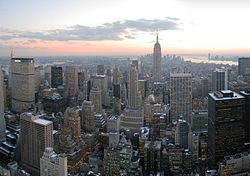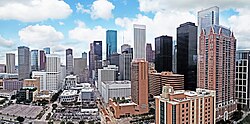









This is a list of the largest urban agglomerations in North America . It includes the 50 most populated urban agglomerations as determined by either CityPopulation.de or Demographia. Demographia's analytical tool is the "urban area" which may be considered as a narrower construct than the "urban agglomeration" which often include more peripheral suburbs.
| Name | Main Country | Rank | City Population estimate [1] | Rank | Demographia estimate [2] |
|---|---|---|---|---|---|
| Mexico City | Mexico | 1 | 24,900,000 | 1 | 21,905,000 |
| New York City | United States | 2 | 23,100,000 | 2 | 21,396,000 |
| Los Angeles | United States | 3 | 17,700,000 | 3 | 15,587,000 |
| Chicago | United States | 4 | 9,900,000 | 4 | 8,954,000 |
| Toronto | Canada | 5 | 9,765,188 [3] | 9 | 6,837,000 |
| Washington | United States | 6 | 8,800,000 | 5 | 7,853,000 |
| San Francisco | United States | 7 | 7,950,000 | 8 | 6,844,000 |
| Boston | United States | 8 | 7,850,000 | 6 | 7,429,000 |
| Dallas | United States | 9 | 7,550,000 | 7 | 6,979,000 |
| Philadelphia | United States | 10 | 7,550,000 | 12 | 5,795,000 |
| Houston | United States | 11 | 7,050,000 | 10 | 6,703,000 |
| Miami | United States | 12 | 6,450,000 | 11 | 6,139,000 |
| Atlanta | United States | 13 | 6,100,000 | 13 | 5,702,000 |
| Detroit | United States | 14 | 5,850,000 | 18 | 4,258,000 |
| Monterrey | Mexico | 15 | 5,850,000 | 14 | 4,674,000 |
| Guadalajara | Mexico | 16 | 5,750,000 | 16 | 4,401,000 |
| Phoenix | United States | 17 | 4,825,000 | 15 | 4,617,000 |
| Tampa | United States | 18 | 4,750,000 | 21 | 3,203,000 |
| Seattle | United States | 19 | 4,625,000 | 19 | 4,001,000 |
| Montréal | Canada | 20 | 4,325,000 | 20 | 3,750,000 |
| Puebla | Mexico | 21 | 4,175,000 | 34 | 2,106,000 |
| Santo Domingo | Dominican Republic | 22 | 4,175,000 | 17 | 4,345,000 |
| Denver | United States | 23 | 3,950,000 | 30 | 2,308,000 |
| Orlando | United States | 24 | 3,725,000 | 23 | 3,075,000 |
| Port-au-Prince | Haiti | 25 | 3,525,000 | 45 | 1,712,000 |
| Guatemala City | Guatemala | 26 | 3,325,000 | 27 | 2,765,000 |
| Minneapolis | United States | 27 | 3,300,000 | 26 | 2,796,000 |
| San Diego | United States | 28 | 3,300,000 | 22 | 3,078,000 |
| Cleveland | United States | 29 | 3,100,000 | 25 | 2,871,000 |
| Vancouver | Canada | 30 | 3,025,000 | 28 | 2,484,000 |
| Cincinnati | United States | 31 | 2,825,000 | 47 | 1,698,000 |
| Toluca | Mexico | 32 | 2,650,000 | 49 | 1,672,000 |
| Salt Lake City | United States | 33 | 2,625,000 | 29 | 2,463,000 |
| Charlotte | United States | 34 | 2,575,000 | 24 | 2,879,000 |
| Portland | United States | 35 | 2,500,000 | 33 | 2,117,000 |
| San José | Costa Rica | 36 | 2,425,000 | 35 | 2,106,000 |
| Las Vegas | United States | 37 | 2,375,000 | 31 | 2,260,000 |
| Saint Louis | United States | 38 | 2,350,000 | 32 | 2,247,000 |
| San Antonio | United States | 39 | 2,325,000 | 36 | 2,088,000 |
| Havana | Cuba | 40 | 2,225,000 | 42 | 1,752,000 |
| León | Mexico | 41 | 2,225,000 | 53 | 1,568,000 |
| Tijuana | Mexico | 42 | 2,200,000 | 46 | 1,712,000 |
| Austin | United States | 43 | 2,175,000 | 39 | 1,943,000 |
| Sacramento | United States | 44 | 2,175,000 | 38 | 1,976,000 |
| Indianapolis | United States | 45 | 2,100,000 | 44 | 1,733,000 |
| Kansas City | United States | 46 | 2,100,000 | 41 | 1,794,000 |
| Pittsburgh | United States | 47 | 2,075,000 | 43 | 1,738,000 |
| Jacksonville | United States | 48 | 2,025,000 | 56 | 1,306,000 |
| San Salvador | El Salvador | 49 | 1,930,000 | 48 | 1,677,000 |
| San Juan | United States | 50 | 1,910,000 | 40 | 1,846,000 |
| Panama City | Panama | 57 | 1,620,000 | 37 | 2,067,000 |
| Columbus | United States | 51 | 1,840,000 | 50 | 1,599,000 |